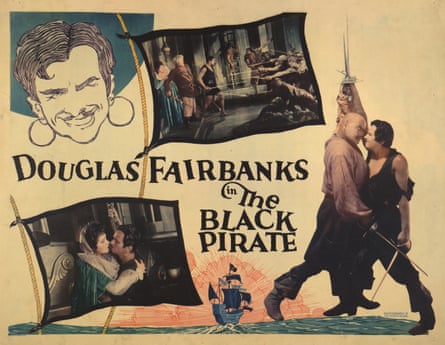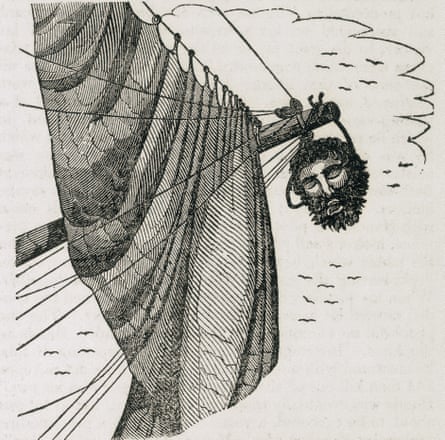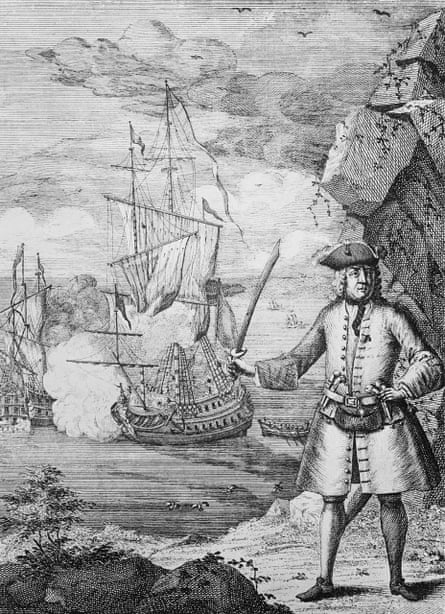In September 1695, the Plymouth-born “king of pirates”, Henry Avery, seized treasure worth £600,000 (in today’s terms, nearly £100m) from the Grand Mughal fleet in the Red Sea. What happened next is uncertain. The most boring legend has Avery – AKA Henry Every or Long Ben – buried in a pauper’s grave in Barnstaple, Devon. Another, recently endorsed in the book Pirate Enlightenment by the late anthropologist and anarchist David Graeber, posits that Avery sailed for Madagascar where he established a pirate republic with his henchmen called Libertalia, a proto-communist utopia where all goods were held common.
The National Maritime Museum in Falmouth offers another account in its fascinating new exhibition, Pirates. After paying off his like-minded hearties in Mughal bling, Avery sailed for home. But nearing Cornwall, he and his pirate booty were shipwrecked and lie deep in Davy Jones’s locker.
Or do they? Stuart Slade, museum deputy director, wants to claim the king of pirates and the legend of the missing treasure for Cornwall. He cites a tantalising 19th-century document in Cornwall’s Record Office in Redruth that purports to reveal the treasure’s location. It says: “About three miles to the east of the Lizard … under three grey stones or rocks in a cove to the south west. It is near where the corner of the high promontory just out into the sea. He said, the spring tides now cover the place.” One chest, the document adds, contains rubies, sapphires, emeralds, topazes and diamonds; another contains more than 150 gold ingots; a third 3,000 pieces of eight.
“Although the area has been thoroughly searched,” says a caption in the exhibition, “nothing has been found.” Now is the time to fire up your metal detector – though if the treasure is ever discovered, you would think the Indian government has first dibs.
Avery was the most successful of those men and women who thrived in the so-called golden age of piracy between 1650 and 1730 in the Atlantic and Indian oceans. The exhibition aims to explore why pirates endure in the popular imagination. It can’t just be because of Johnny Depp’s appropriation of Keith Richards’ mockney drawl in the Pirates of the Caribbean film franchise. Slade says other dressy antinomian figures have their moments – who doesn’t like a dandy highwayman? – but that lawless swashbucklers on the high seas have captivated us ever since 1881, when Robert Louis Stevenson wrote the first half of Treasure Island.
But there is a chasm deeper than the Mariana Trench between piratical reality and fiction. The gap between the be-ruffed dandies and fragile masculinities depicted in Taika Waititi’s recent sitcom Our Flag Means Death and Somali pirates plying the same waters as Avery did centuries earlier could not be more stark. This point is made clear by a glass case containing an old-school cutlass of the kind that captains Blood, Hook and Blackbeard waved in anger, alongside a replica AK-47, the weapon of choice for today’s real pirates.
Slade suggests that we can project our fantasies on to golden age pirates. In the first half of the 20th century, for instance, pirate movies depicted white men (think Errol Flynn and Douglas Fairbanks Sr) on the high seas, swinging in on a yardarm with a cutlass in their teeth to seize not only pirate booty but decorous damsels who, from 2023’s perspective, seem victims of coercion.
This exhibition is keen to problematise such white supremacist masculine narratives by showing us queer pirates, pirates of colour and female pirates. Artwork commissioned for the show from Queer Kernow comes with this caption: “Pirates existed in the shadows, in the margins of society – overthrowing societal conventions and creating their own counterculture.” Such figures as Anne Bonny, Mary Read and John “Calico Jack” Rackham have, as the note puts it, “queer resonances”. We project on this piratical other, in lieu of historical fact, our ever-changing fantasies. “In the 1970s, women pirates were seized on by feminists. Now they’ve become part of a different LGBTI+ discourse,” says Slade.

An 1852 engraving of Mary Read by A Catel for the book Histoire des Pirates depicts a bloodied tar lying vanquished on a beach. The cutlass-wielding pirate standing over him pulls back her top to reveal her breasts. The man’s shocked and rueful expression, to me at least, says: “Bad enough to be beaten, but beaten by a girl!”
Few pirates, we learn, were persons of colour – but reportedly six out of 10 of Edward “Blackbeard” Teach’s crew were black. Among them was Black Caesar, posited here to have been west African and an enslaved person, who escaped the wreckage of a slave ship during the Atlantic crossing and was later hanged in Williamsburg, New York.
Many pirates realised that there was money to be made from African bodies. “It is tempting to imagine that freedom-loving pirates might release enslaved people,” says the caption. “But usually, they were treated just as inhumanely by the pirates and sold for profit, or in some cases thrown overboard to drown.”
Not surprisingly, pirate legends are not especially alluring in today’s Caribbean, where many people’s ancestors were enslaved. Alexis McDavid, of the National Museum Jamaica, says: “Today it’s seen as being very Eurocentric.” That said, when the then Jamaican capital of Port Royal was partially destroyed by a 7.5-magnitude earthquake in 1692, it was regarded as God’s wrath over this modern Sodom in which sex work and piracy thrived. And Jamaica hasn’t erased its piratical past: today, the sunken pirate city is a national heritage site, open for diving excursions and hailed by some as an underwater Pompeii.

The romantic idea of pirates living free and democratically outside straight society nonetheless persists. Graeber suggested: “The toothless or peg-legged buccaneer hoisting a flag of defiance against the world … is, perhaps, as much a figure of the Enlightenment as Adam Smith or Voltaire, but he also represents a profoundly proletarian liberation, necessarily violent and ephemeral.”
Ephemeral is right: Slade estimates that pirates lasted on average two years at their illegal trade before being hanged, drowned or sensibly retiring. In some iterations, the Jolly Roger flag includes not just skull and crossbones but an hourglass, to make the point that the life of the pirate was nasty, brutish and – even if an adrenaline-fuelled rollercoaster – short.
Welsh pirate Bartholomew Roberts (AKA Black Bart or, in Welsh, Barti Ddu) died aged 39 after seizing 400 prizes, possibly a pirate world record. Legend has it that Teach wove hemp into his beard and set it alight before battle in order to intimidate his enemies. Fear, as much as cutlasses and gunpowder, was a leading weapon.
What, apart from unimaginable riches and the promise of intercontinental leg-overs, attracted people to become pirates? “It wasn’t as hierarchical as the Royal Navy,” says Slade. “Captains were elected. And they lived according to a code.” The exhibition sets out the code that prevailed on Black Bart’s ship. According to article one: “Every man has a vote in affairs of moment; has equal title to the fresh provisions, or strong liquors, at any time seized, and may use them at pleasure.”

Exhibits include a haul of pieces of eight loaned from the British Museum and an immersive installation replicating the video game Sea of Thieves. Perhaps the best exhibits in the show, though, are the mannequins dressed in replicas of the high street knock-offs of the pirate outfit Vivienne Westwood designed in 1981. If the gift shop doesn’t include replicas of those replicas, I’ll be astounded.
If the pirates emerge from this show as questionable characters, then its real hero is Stevenson, whose Treasure Island created many of the enduring emblems of the pirate genre: the one-legged rogue, the cabin boy hiding in an apple barrel, the map to the buried treasure marked by an X. Former poet laureate Andrew Motion, who has written two sequels to Treasure Island, says of Stevenson: “He never wrote a bad line.”

And yet Stevenson is neglected: he rarely figures on school recommended reading lists. Treasure Island is best known through words that are not Stevenson’s own – from illustrated abridgements, and more than 50 film and TV adaptations including Muppet Treasure Island and one featuring Mr Magoo.
The show ends with a real gibbet loaned by Rye Castle Museum. The golden age of piracy came to a bloody end in the 1730s as governments decided pirates were too much of a liability to trade and stamped them out. “We went back and forth on whether to include the gibbet,” says Slade. “But we decided that the brutal truth needs to be shown.”
Captain Kidd was among the pirates to be executed. He was hanged twice at Execution Dock in Wapping, London. The rope broke on the first attempt and despite some people in the crowd shouting it was a sign from God that he should be released, minutes later he was hanged again. His body was displayed on a gibbet at Tilbury Point over the River Thames – a warning to future pirates.
Avery probably eluded the noose, though where he met his end and what happened to his treasure remains uncertain. The likelihood is that there be treasure in these Cornish parts, Jim lad. Possibly.

